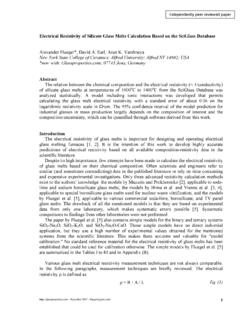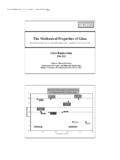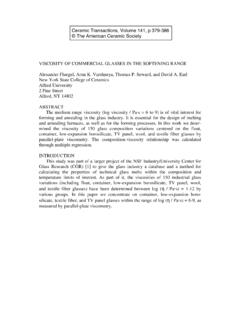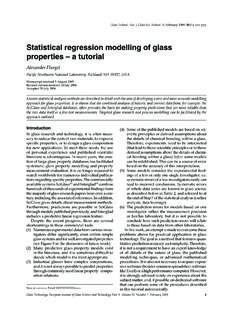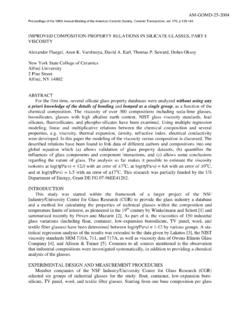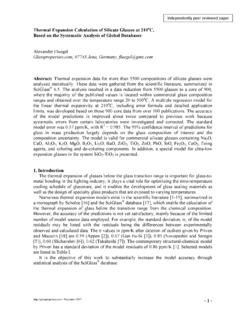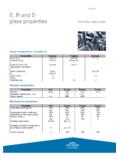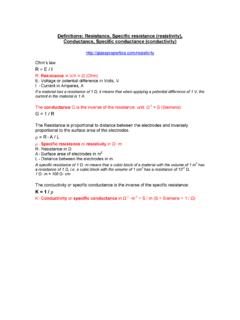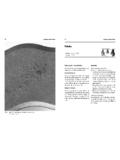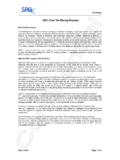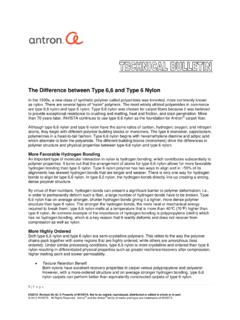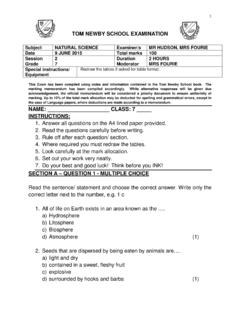Transcription of Density and thermal expansion calculation of silicate ...
1 Physics and Chemistry of Glasses: European Journal of Glass Science and Technology Part B Volume 49 Number 5 October 2008245 IntroductionThe Density and the thermal expansion of glass melts are important factors for glass furnace modelling. When combined with the knowledge of the viscos-ity temperature curve, bubble content, temperature distribution, thermal conductivity, and other factors, it is possible to calculate the convective flow in a furnace tank. Furthermore, Density and thermal expansion play important roles during glass fining and forming, during gob formation, glass fiberi-sation, and the float process. Despite its importance, the reported measurements of glass melt Density and thermal expansion are few (compared to room temperature Density and thermal expansion ) because of experimental SciGlass database and information system,(1) which summarises the findings from most glass re-lated publications in material sciences over more than 100 years, contained at the time of this study 1698 chemical composition Density data of glass melts in the range of 800 to 1400 C.
2 Most of the data, however, can not be used directly for technical application because of the unusual compositions studied, silica-free borates and high lead glasses, or glasses with high concentrations of transition metal oxides, phosphor pentoxide, cesium oxide, rubidium oxide, or bismuth oxide. The glass database Interglad(2) did not list any glass melt Density or thermal expansion values at the time of the present , in this work, an attempt was made to condense all information available in the SciGlass infor-mation system about the Density of silicate glass melts containing more than 40 mol% silica, less than 40 mol% boron oxide, varying amounts of Al2O3, Li2O, Na2O, K2O, MgO, CaO, PbO, and minor components into a multiple regression model. Because of insufficient data, BaO and SrO-containing glass melts were not modelled. An adequately accurate model of Density as a function of temperature enables one to calculate the coefficient of thermal expansion (CTE) of glass Density of glass melts has been determined using the following techniques:(3,4) (1) the Archimedes methods;(3 6) (2) the pycnometric technique;(7) (3) the pendant and sessile drop method;(3,8 12) (4) the maxi-mum bubble pressure method (through bubble pres-sure variation);(13,14) (5) measurement of the thermal expansion at higher viscosity(15,16) combined with low temperature Archimedes method experiments; (6) flotation;(17) (7) and gamma ray absorption.
3 (18,19) The reader may refer to the listed references for further this study the following nomenclature will be used:Coefficient of linear thermal expansion CTEL= L/(Lo T ) (1)Coefficient of volume thermal expansion CTEV= V/(Vo T)= /( T T) (2)CTEV 3 CTEL (3) (within relatively narrow temperature intervals)whereLo, Vo, o Initial length/volume/ Density of the sample T Density of the sample after the tempera-ture change T, T= o+ L, V, Change of the length/volume/ Density of the sample due to the temperature change T; for expansion L, V posi-tive, negativeDensity and thermal expansion calculation of silicate glass melts from 1000 C to 1400 CAlexander Fluegel,* David A. Earl, Arun K. Varshneya & Thomas P. Seward IIINew York State College of Ceramics, Alfred University, Alfred NY 14802, USAThe relation between the chemical composition and the Density of silicate glass melts at temperatures of 1000 C to 1400 C was analysed statistically.
4 The analysis was founded on all 140 to 260 available values in the SciGlass information sys-tem for compositions containing more than 40 mol% silica, less than 40 mol% boron oxide, varying amounts of Al2O3, Li2O, Na2O, K2O, MgO, CaO, PbO, and minor components. A model based on multiple regression was developed. The 95% confidence interval of the mean model prediction on the Density was 0 5 to 3%, depending on the composition of interest. The prediction of Density as a function of temperature made possible the estimation of the coefficient of thermal expansion in the molten state to within 20 to 40% error with a 95% level of Corresponding author. Email Now with: European Patent Office, 2288 EE Rijswijk, The NetherlandsPhys. Chem. Glasses: Eur. J. Glass Sci. Technol. B, October 2008, 49 (5), 245 257 Fluegel et 24510/10/2008 18:05:40246 Physics and Chemistry of Glasses: European Journal of Glass Science and Technology Part B Volume 49 Number 5 October 2008 The CTE is the average slope of the L/Lo=f(T) or V/Vo=f(T) curve within the temperature interval T, whereby the linear expansivity or the volumetric expansivity is the first derivative of the L/Lo=f(T) or V/Vo=f(T) curve over T.
5 (20) The expansivity is also referred to in the literature as instantaneous coef-ficient of thermal expansion or true expansivity or true coefficient of thermal expansion where the CTE can be called average coefficient of thermal expansion . In general, the expansivity increases with increasing temperature, which means that the CTE increases as well with increasing T and/or if T is reported at higher temperatures. If the expansivity is relatively constant within a sufficiently narrow tem-perature interval, the coefficient of volume thermal expansion CTEV is about three times the coefficient of linear thermal expansion glasses, it is mostly observed that the expansiv-ity below the glass transition temperature Tg increases only slightly with increasing temperature. In the glass transition region up to the liquidus temperature, the expansivity often increases 3 to 5 times, compared to the expansivity of solid glass at room temperature.
6 (16) The expansivity again becomes relatively constant well above the liquidus temperature.(16)Within the temperature interval of 1000 to 1400 C studied in this work, it was assumed that the expan-sivity of glass melts can be approximately set to be a constant, = unit of the Density used in this study is g/cm3, while the expansivity and CTE are expressed in ppm/K=10 10 7 K 1. The reciprocal of Density , the volume of 1 g of a substance, is called the specific volume (unit: cm3/g).Statistical data analysis(21 24)Most of the statistical analysis techniques applied in this paper are explained by the author in detail in Refs 25, 26. The model equation was based on a slack vari-able model using a polynomial function of the second degree as seen in Equation (4).(25,26) The coefficients are b, with bo being the intercept, bi the single component coefficients and the coefficients of squared influences, and bik the coefficients of two-component interactions.
7 The variable n in Equation (4) is the total number of the significant glass components, excluding silica; i and k are individual numbers of the significant glass components, and Ci and Ck are the component con-centrations (excluding silica) in mol%. Ci and Ci2 are defined as single component factors, and the products CiCk are interaction factors:Densityoi iikik= ++ == bbCbC Ck inin1 (4)The Density in Equation (4) is the glass melt Density in g/cm3 at 1000 C, 1200 C, and 1400 C, respectively. In the commonly applied ordinary least squares (OLS) regression, also used in this study, the coeffi-cients in Equation (4) are determined by mathematics programs through Equation (5) with Y being the 1-column matrix of all experimental observations (glass melt densities), and B the 1-column matrix containing the coefficients b. The X in Equation (5) is the matrix including all significant factors, and XT is its transpose matrix.
8 Table 6 in the modelling results section below provides an example of the factor matrix X. The operation 1 indicates matrix inversion, and the sign stands for the scalar or dot product. Tables 3 5 in the modelling results section summarise all matrix products XT X in this work, called information matricesB = (XT X) 1 XT Y (5)It is important to evaluate factor correlations before regression analysis is performed. The linear correlation matrix is made up of the simple, or two-way, correla-tion coefficients. They are denoted by the letter r and have a range of 1<r<+1 (Pearson s r). The correlation coefficient for two factors (independent variables) is a measure of the linear relationship between the two factors. If r is close to 1, then a plot of the two factors against one another would look like a straight line with a positive slope. If r is close to negative 1 then the plot of the two factors against one another would look like a straight line with a negative slope.
9 If r is close to zero then a plot of the two factors would show no discernible linear selecting the appropriate modelling approach, correlations between changes in the component concentrations and/or their interactions (concentra-tion cross products) have to be considered if the data were not collected using a statistical design that is orthogonal for all of the factors of interest. If the absolute value of r is larger than approximately 0 5 to 0 6, the influences of the two considered factors are partially correlated ( linked but not com-pletely aliased) and may be difficult to separate. If the absolute value of r is larger than approximately 0 8 to 0 9, the influences are correlated so strongly that they may not be separated at all in most cases, and the factors should be combined, or one factor should be excluded. Equation (6) can be used to calculate r, with n being the number of experiments and x and z the variables that need to be tested for correlation:rxzxznxxnzzn=-( )-( ) -( ) () ////22221 2 (6)The t-value (also called t-statistic) is an indicator of the significance of a model factor (component concentration or concentration product).
10 In other words, it is a measure of how much information a factor adds to the model. In general, a t-value with A. Fluegel et al: Density AnD thermal expansion calculation oF silicate glAss meltsFluegel et 24610/10/2008 18:05:41 Physics and Chemistry of Glasses: European Journal of Glass Science and Technology Part B Volume 49 Number 5 October 2008247absolute value greater than or equal to 2 is consid-ered to be significant, with a statistical confidence level of approximately 95%. Most minor components are insignificant, their influence is less than the standard error (noise). The t-value is calculated from the quotient of the considered coefficient b and the standard error of the coefficient Sb. In general, the absolute t-value tends to increase with (1) increasing number of experiments, (2) decreasing standard error of the regression model (see below), (3) decreasing correlation between the levels of the different com-ponents, and (4) increasing variation of component levels (wider component concentration limits).
